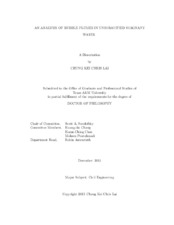| dc.description.abstract | Multiphase flows are ubiquitous in nature and engineering scenarios; examples include volcanic eruption, cloud formation, land reclamation and subsea oil well blowout.
In these flows, one or more heterogeneous materials is/are transported by a turbulent carrier fluid (fluid, hereafter). Their interactions, as embodied in the fluid velocities, determine the final fate and transport of the heterogeneous materials. This dissertation investigates how turbulent kinetic energy (TKE) is created and injected into surrounding fluid by the rising bubbles in an air-water bubble plume. This analogue flow shares many similar fluid mechanical properties with oil well blowout plumes whose knowledge is important in disaster management. A comprehensive experimental program using acoustic Doppler velocimetry (ADV) and planar particle image velocimetry (PIV) has been carried out to measure fluid velocities inside the time-steady two-phase plume. Radial profiles of diffusion of TKE and turbulent dissipation rate are reported for the first time. From the fluid-phase TKE budget, it is found that approximately 55-60% of the total work done by bubbles is used to create turbulence in the carrier fluid. Results on the auto-spectral density function of velocity fluctuations reveal a -8/3 spectral slope instead of the classic Kolmogorov-Richardson value of -5/3, suggesting a fundamental difference in spectral energy transfer in this two-phase ow when compared to other simple boundary-layer shear flows, such as a singe-phase jet. This is supported by the subgrid scale (SGS) dissipation computed from the PIV data where it can be seen that the direction of energy cascade is always forward for a simple jet whereas it can be backward for the two-phase plume. On the other hand, a data interpolation method based on first-order autoregressive processes is developed to replace faulty or missing data in a time series of turbulent velocities. The method is shown to preserve both spectral slopes and energies of frequency components, for the range of slopes between -7/6 to -8/3. Further, the classical sample and hold interpolation is shown to be the limiting behavior of a first-order autoregressive process and therefore has theoretical underpinnings hitherto unknown in the literature. | en |


